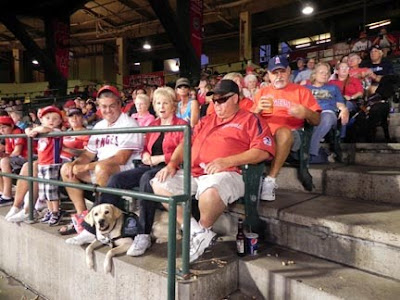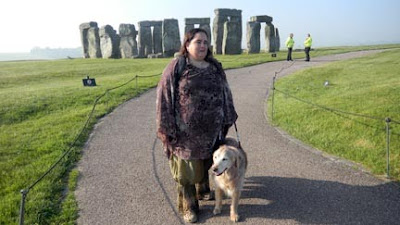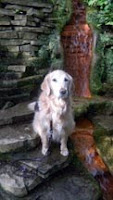
When the Seattle Mariners took on the Los Angeles Angels at Seattle's Safeco Field a few weeks back, they were being cheered on by some very special four-footed fans - puppies!
Ten Seattle-Area puppy raising clubs filled the stands with Guide Dog puppies, puppy raisers, and community supporters - more than 600 supporters in all. The event was a fundraiser for the puppy clubs, and due to their impressive ticket sales, Guide Dog puppies were able to take to the field prior to the game, and a GDB representative got to throw out the first pitch! Bob Sonnenberg, with his black Lab guide Nino beside him on the mound, sent the ceremonial pitch blazing across home plate. (Photo by Ben VanHouten, Seattle Mariners.)
GDB alumnus Randy Tedrow and his guide, Clark, were at the game. He submitted this tale of their Safeco Field adventure:
Clark and the Lost Hat
I lost my hat! I lost my very nice hat made of fine wool felt. It is, or was, a very nice hat. Clark and I were at a Mariners baseball game. The Mariners are not the important part of the story, they only provide the backdrop to the sad story of my lost hat.
Clark and I went to the game with about 20–30 GDB puppy raisers, or maybe it was 200–300 (I know there were a lot of puppy raisers!). The puppy raisers had sold a lot of tickets to the game. Clark and I were there representing GDB to all the adoring fans, some of whom were even there for the Mariners!
A nice puppy raiser named Miss Patty picked Clark and I up and we had a nice trip to the field. I had never been to a baseball stadium so early before! We were there before they were letting people inside. In fact, they didn’t want to let us inside until the gates opened. We were there before they even started selling coffee! Can you believe that? We're in Seattle and the coffee wasn’t being sold?
We got inside and I was given a handy name tag to hang around my neck. Clark was having a blast like he always does in a new place. I had to feel sorry for the puppy raisers because they had to walk slower since their puppies weren’t up to Clark speed yet. But, there were lots of cute puppies and proud puppy raisers.
Clark loved working in the wide, almost empty concourses of the stadium. We were almost running and his tail was tapping out a happy rhythm on my leg. We got to the place just back of home plate and well, we waited.
It was fun to talk with some of the other handlers and meet a bunch of puppy raisers. They were all nice people, particularly the ones who got me coffee!
Now, I am very graceful and promptly spilled my first Starbuck’s coffee! I am very good at spilling coffee and like to keep in practice. Clark was not impressed since he had to get up from his nap to keep from getting burned. Sigh. Fortunately, the coffee people were forgiving and I got another cup.
Once the gates were opened we got busy! We answered many questions about Guide Dogs and raising puppies. One couple brought their adopted retired Guide Dog and he became the petting dog. This was nice for everyone. There were so many people that I decided not to let anyone pet Clark, otherwise, the black on his fur might have been rubbed off. There is nothing quite so sad as a black Lab who has rubbed off spaces in his black fur.
Of course, people were impressed with how well behaved Clark was. There were three Guide Dogs at our table and all were so well behaved. I think it amazed the passersby and encouraged the puppy raisers.
It was a windy evening at Safeco Field and we could feel the wind inside the concourse. It was so windy, that Chicago got jealous! At some point, Miss Patty helped Clark and I get to the relieving area that had set up for the dogs - it was quite the trek: we were on the 100 level and the relieving area was on the 300 level. The wind was so strong, that it almost blew my name tag off. I managed to rescue the name tag, however, I didn’t manage to rescue my hat.
I discovered that my hat was missing when some friends stopped by later during the game to say hello. I went to show them my hat... and no hat! My hat, my very nice hat made of fine wool felt was gone!
We began a frantic search. It wasn’t near my back pack. It wasn’t at the Starbuck’s and Miss Patty couldn’t remember seeing me with it. In fact, no one could remember if I had it or not! My hat was gone! And, it was raining! I remember the sinking feeling in my stomach and wondered how I could tell Valerie it was gone. She had gotten me my very nice hat for Christmas a few years back. Oh no!
We made our way home from the game, and I dreaded telling Valerie my hat was gone. Thankfully, Valerie wasn’t home yet. I breathed a sigh of relief and went to get a leash to take our pet dog out to do her business. I opened the closet where the dog stuff is kept and right there on its hook was my hat! My very nice hat made of fine wool felt, a very nice hat indeed, was not lost! I had not even taken it to the ball park! Yeah! A Mariner's win and a found hat. How's that for a happy ending?

 y current role as a field service manager, I wear a lot of hats: trainer, behaviorist, vet assistant, orientation and mobility specialist, grief counselor, transportation specialist and even occasionally a light housekeeper!
y current role as a field service manager, I wear a lot of hats: trainer, behaviorist, vet assistant, orientation and mobility specialist, grief counselor, transportation specialist and even occasionally a light housekeeper!








 Getting held back by Eurostar going from France to England which resulted in an unexpected stay in Paris and Tessa ending up with a French passport.
Getting held back by Eurostar going from France to England which resulted in an unexpected stay in Paris and Tessa ending up with a French passport.
